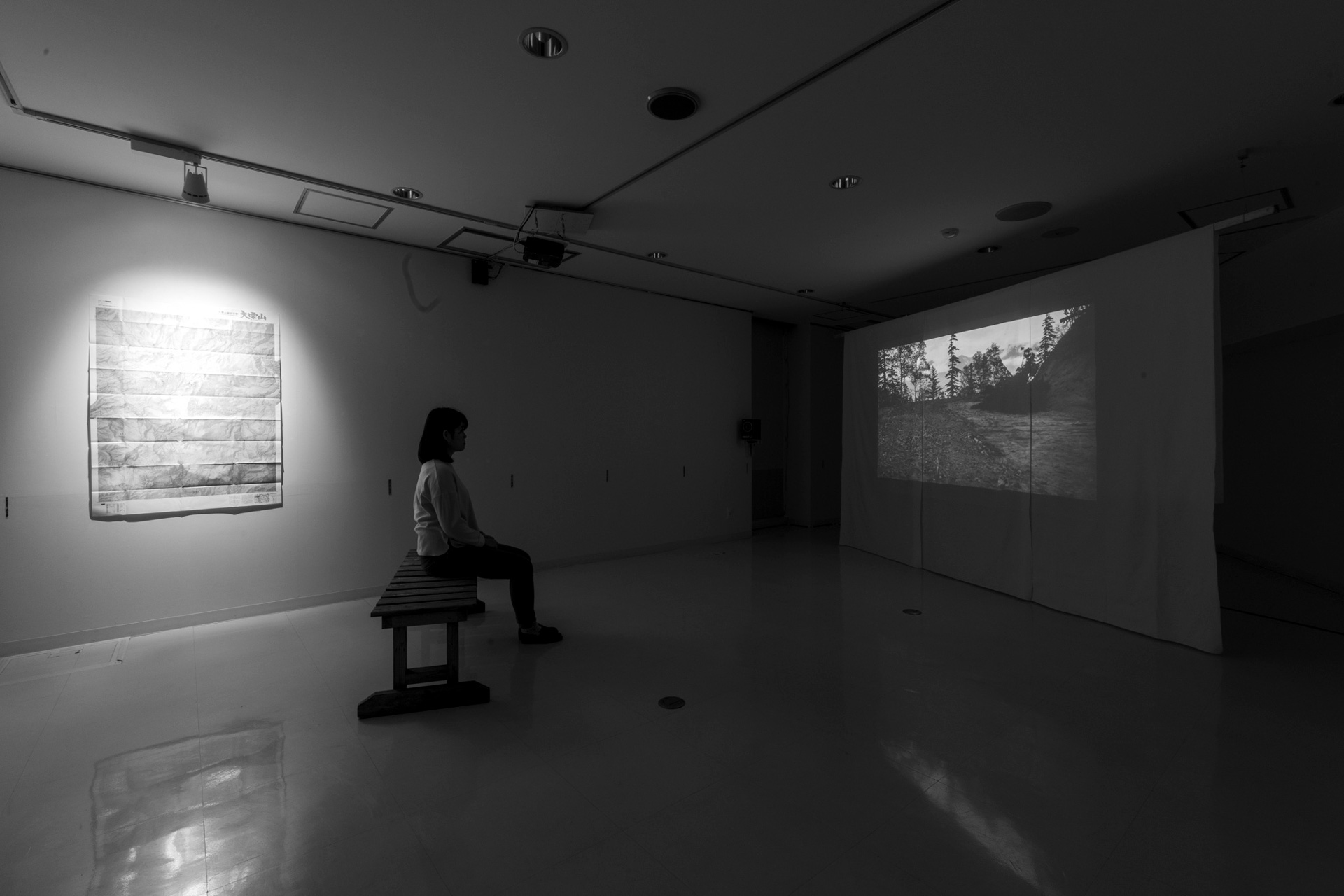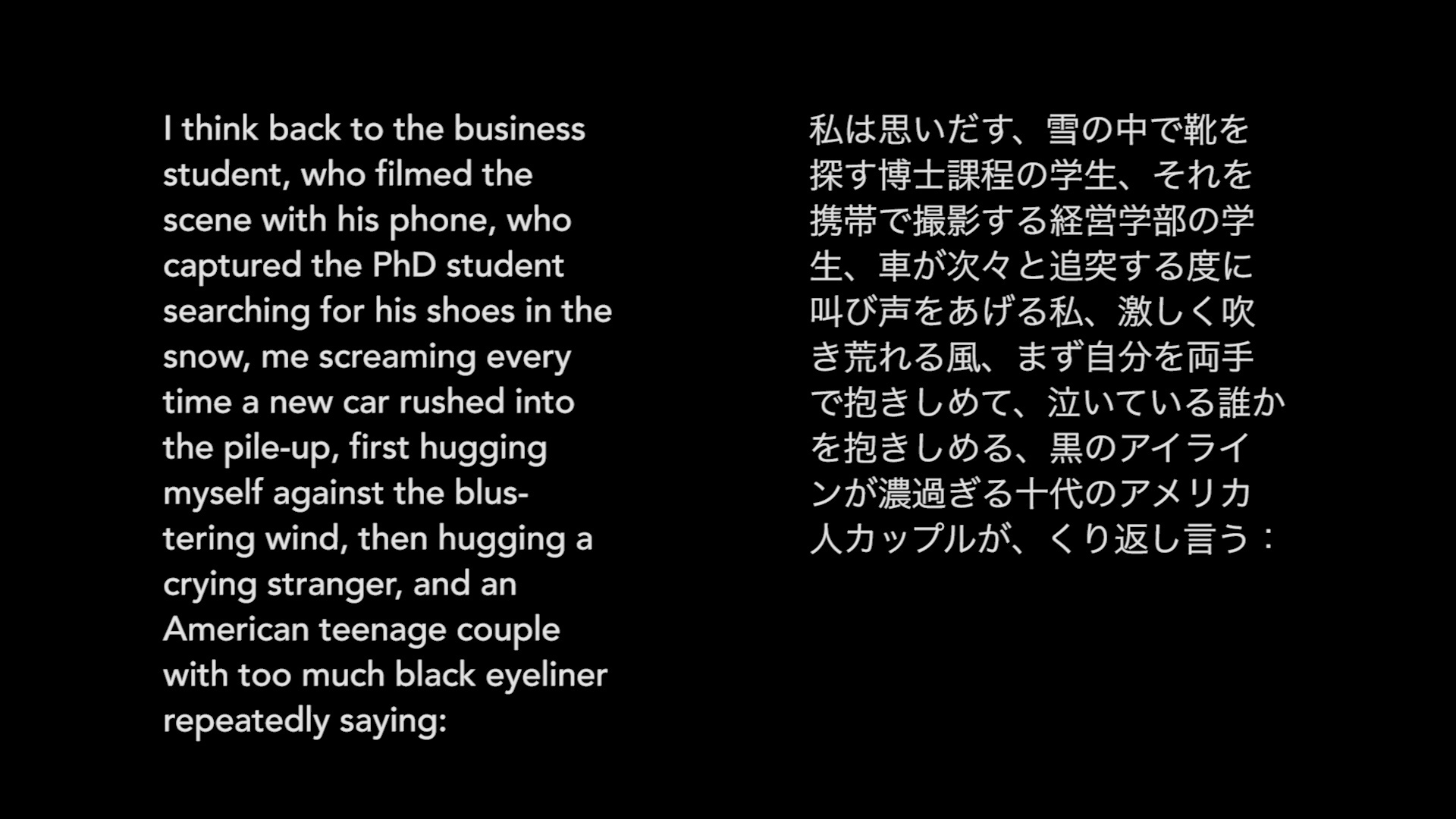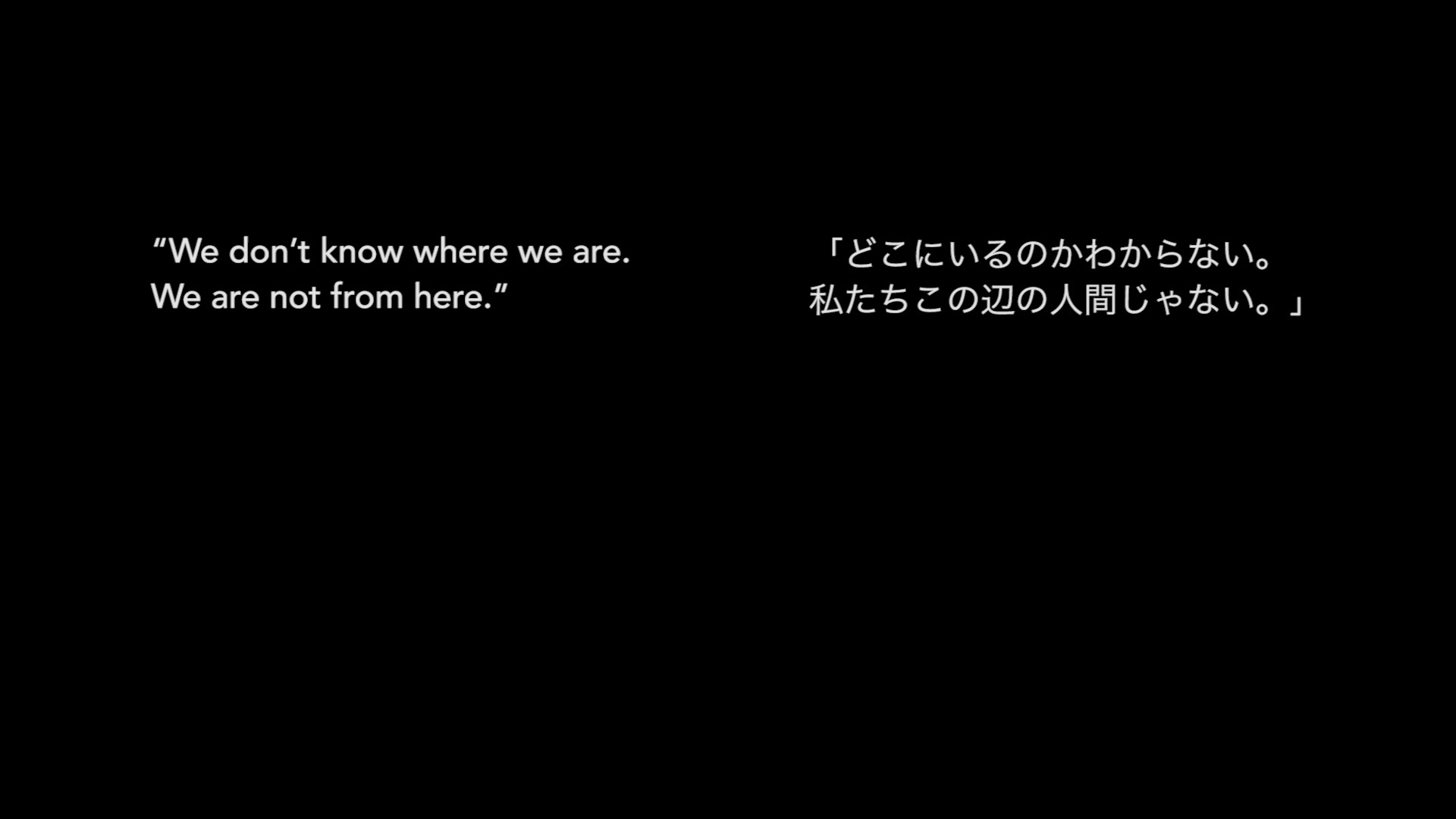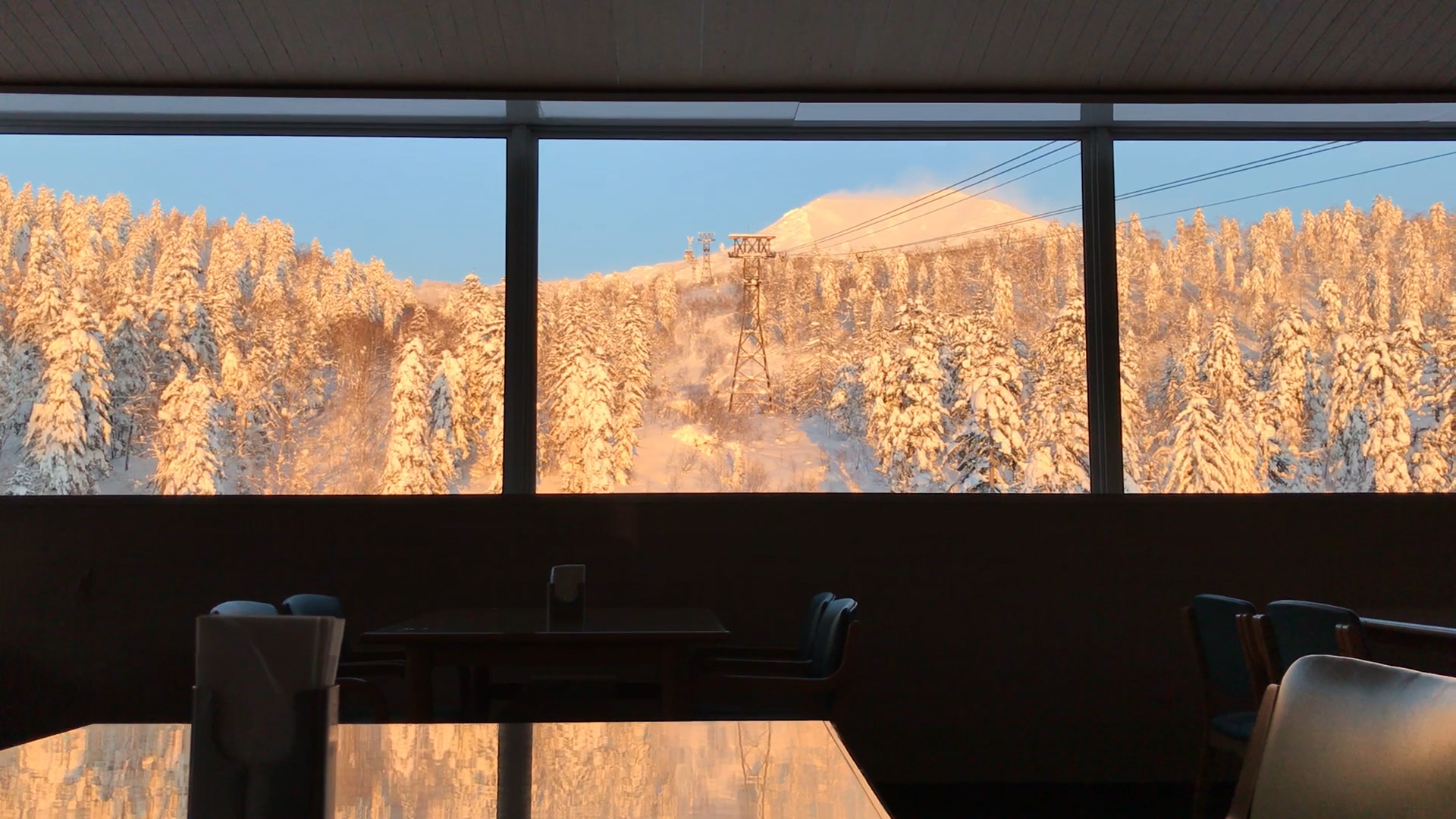Undine Sommer
Visual Art ︎︎︎
This Beauty Deserves a More Dramatic Song
Like a whiteout, "This Beauty Deserves a More Dramatic Song" brings in and out of focus the director's near-fatal car accident during a snowstorm in Canada and seemingly disjunct events in Hokkaido's Daisetzuzan Mountain Range: The construction of the Sounkyo Hydroelectric Power Plant in 1952 and the Daisetzuzan Sightseeing Road from 1954 until its halt by the Hokkaido Nature Conservation Society in 1967, the devastation of Daisetzuzan’s primeval forest in 1954 by Typhoon 15, and Seiji Hisamatsu’s 1957 screen adaptation of poet Ujō Noguchi getting lost in Daisetzuzan's dramatic landscape during his search for his love.
As an uninvited guest, the director traverses through remembrances, archives and landscapes deeply affected by settler-colonial actions in Canada and Hokkaido.
Ultimately, what does it mean to have sight taken by nature and to take sight of nature? And how does fueling the desire to see a landscape differ from constructing a road right through it?











In the winter I travel with
three strangers in a
rideshare from Montreal to
New York City.
冬のある日、私は3人の見
知らぬ人と車を相乗りして
モントリオールからニュー
ヨークへ向かう。
Just before the US
border we get in a snow storm.
米国との国境間近で吹雪が
私たちを襲う。
Snow is falling from the sky
as well as blowing from the
neighbouring fields onto the
highway.
降雪と平原から吹く風で
高速道路に雪が舞い上がる。
The view is milky and
powdered sugary and the
sounds are all muffled.
視界は真白く粉砂糖のよう
すべての音は籠もっている。
It’s a dreamy feeling and
I think about filming it with
my phone.
夢見心地の私はその情景を
自分の携帯で撮影しようと
思う。
Weird, how we just trust the road.
なぜかみんな道路を信頼している。
…
…
The driver is a sound
designer for film. We both
squint our eyes and try to
see any other cars.
運転手は映画の音響技術
者。私たちは目を細めて周
囲の車を見ようとする。
Thirty seconds later,
non-moving objects
appear
on the road.
30秒後、全く動かない何か
が路上にあらわれる。
A mattress,
マットレス、
sheets,
シーツ、
pieces of wood,
木の破片、
pieces of plastic,
プラスチックの破片、
something red,
赤い何か、
something black,
黒い何か、
a truck.
1台のトラック。
Later, I am told, I woke up
my fellow passengers on
the
back seats with my scream.
あとで後部座席の客が、私
の叫び声でとび起きたと言
う。
I don’t remember
screaming.
私は叫んだことを覚えてい
ない。
I only remember that in
these couple of seconds,
I was acutely aware that this is
how I might die: smashed
into
a
shattered camping van
that had smashed into a truck.
その数秒間、私はトラック
にぶつかり、潰れたキャン
ピングカーの中に閉じ込め
られて死ぬと思っていた。
それ以外のことは覚えてい
ない。
The view all milky and
powdered sugary. The
sounds all muffled.
視界は真白で粉砂糖のよう
すべての音は籠もってい
る。
Nomadic poet Ujō Noguchi
travels to Hokkaido in search
of his girlfriend Kayo.
Heading to Sōunkyō he gets
in a blizzard.
放退の詩人、野口雨情は遠く
北海道に渡ったと聞く恋人加
代の姿を求めて散策の旅に出
る。そして吹雪の中を層雲峡
に向うのである。
Director Seiji Hisamatsu turns
the camera to Happodai and
Obako-Kobako capturing the
beauty of Sōunkyō and the
Daisetzuzan Sightseeing Road.
久松静児監督の手により、詩
を愛し、庶民を愛した野口雨
情の旅情の様子を、八方台そ
して、大画小画へとキヤメラ
を廻し、雪に閉された層雲峡
と、この大雪山観光道路の美
しさを余すとこなく捉えてい
る。
Morishige, who plays Ujō
Noguchi speaks about the
breathtaking beauty of
Sōunkyō and the majesty of
Happodai:
雨情を演ずる森繁久弥はこの
言語に絶する層雲峡渓谷美と
八方台の雄大さに対し、次の
ように語っていた。
町長さん、何とかしてこの美しさに俗人の手を入れないでほしい。
Mayor, I want you to somehow keep this beauty
out of the hands of ordinary people.
Mayor, I want you to somehow keep this beauty
out of the hands of ordinary people.
The construction of the
Sōunkyō Power Plant has
been completed.
層雲峡発電所の建設は施工
された。
Compensation for the lost
stratus clouds, the primal
landscape and the
mysterious gorge is
absolutely imperative.
原生そのまま神秘をたたえ
た、失われる層雲峡の景観
の補償は絶対にして貰う。
A terrible atmosphere
surrounds this place like a
scar of war. There are only
a few dead ezo and todo
trees still standing within
one square kilometer of the
plateau. Facing the sky as
if they were white bones.
大戦争の跡のような凄惨な
空気が漂い、一キロ四方に
もわたるであろう台地のと
ころどころにエゾ、トドの
枯木が白骨のように天をつ
いている。
There are, however,
rootstocks and dead
branches with a diameter
of four or five meters that
have been turned upside
down, scattered every-
where, conveying the
violent pattern at the time.
根こそぎひっくり返った直
径四、五メートルもある根
株や枯枝はいたるところに
散在して、荒々しい当時の
模様を伝えている。
The peaks of Mt.
Kurodake, Mt. Eboshidake,
and Mt. Akadake are calm
due to the remaining snow.
But how sorrowful is the
song of the birds here!
黑岳、鳥帽子岳、赤岳の
峰々が静かに残雪を戴いて
おだやかである。しかし、
なんとここの山鳥の鳴声は
悲痛に聞えることであろう
か!
I wrote earlier that I would
definitely recommend to
include this place on a
sightseeing road.
私はさきに、観光ルートに
ぜひこの場所を予定してほ
しいと書いた。
I can imagine people
experiencing deep
emotions from this intense
contrast between life and
death.
この生と死のはげしい対照
の中から、人々がそれぞれ
の感慨をつかみとるであろ
うことを想像するからであ
る。
Surely, such a place along
a beautiful sightseeing
route would make the
itinerary more meaningful.
美しい観光ルートの中に、
このようなところが一カ所
ぐらいあっても、いやあっ
た方が、より旅程を有意義
なものにすることを確信し
たい。
Five hours later in a
community center, I feel a
bond with my fellow
passengers.
5時間後、公民館にいる私
は同乗者との絆を感じてい
る。
“It’s crazy how the only
reference point to a
situation like this are
movies,” says the film
studies PhD candidate.
「こんな状況を映画でしか
例えられないなんておかし
い」と、映画研究する博士
課程の学生が言う。
I think back to the business
student, who filmed the
scene with his phone, who
captured the PhD student
searching for his shoes in
the snow, me screaming
every time a new car
rushed into the pile-up, first
hugging myself against the
blustering wind, then
hugging a crying stranger,
and an American teenage
couple with too much black
eyeliner repeatedly saying:
私は思いだす、雪の中で靴を
探す博士課程の学生、それを
携帯で撮影する経営学部の学
生、車が次々と追突する度に
叫び声をあげる私、激しく吹
き荒れる風、まず自分を両手
で抱きしめて、泣いている誰
かを抱きしめる、黒のアイラ
インが濃過ぎる十代のアメリ
カ人カップルが、くり返し言
う:
“We don’t know where we
are. We are not from here.”
「どこにいるのかわからな
い。
私たちこの辺の人間じゃな
い。」
Maybe for some people
this recording will be a
reference point.
一部の人々にとっては、こ
のビデオが一つの例えにな
るでしょう。
Walking home
家へ帰る途中
when the fields were all white
平原はどこまでも白い
and the sky all blue,
空はどこまでも青い
I used to fall to the ground.
そんな日はよく転んだ。
What’s up and what's down
どっちが上か下か
became unclear.
わからなくなって。
Was this a dream?
それは夢の話?
I ask my friend.
私は友人に聞く。
No, she says.
いいえ、と彼女は言う。
installation. video (hd 16:9, stereo sound, color, one-channel, 19:45 min) bench, wooden beam, cotton fabric. sapporo/hokkaido. 2020.
Concept, Directing: Undine Sommer
Camera: Shusuke Nishimatsu, Undine Sommer
Sound Recording: Undine Sommer
Production Assistant: Shusuke Nishimatsu
Driver: Isozaki Michiyoshi
Editing, Sound Design: Undine Sommer
Translation: Chiaki Sakaguchi, Shusuke Nishimatsu
Installation: Hiroki Yamada, Shusuke Nishimatsu, Mami Odai, Yuki Hanada, Ryotalo Kobayashi
Production Coordinator: Chiaki Sakaguchi
Special Thanks: Kamikawa Heritage Museum, Tengshing Kazama & Family (Thosenji Temple), Fumiko Kikuchi, Mami Odai, Dr. Ken Sato (Hokkaido Nature Conservation Society), Shimabuku, Sōunkyō Visitor Center, Takahiro Urushi, The Museum of Ujō Noguchi
Very Special Thanks: Daisetzuzan Nationalpark
Developed on invitation by and with great support of Sapporo Tenjinyama Art Studio
Installation documentation © Yoshisato Komaki
Archival images © Kamikawa Heritage Museum
Video stills other than archival images © Undine Sommer
Concept, Directing: Undine Sommer
Camera: Shusuke Nishimatsu, Undine Sommer
Sound Recording: Undine Sommer
Production Assistant: Shusuke Nishimatsu
Driver: Isozaki Michiyoshi
Editing, Sound Design: Undine Sommer
Translation: Chiaki Sakaguchi, Shusuke Nishimatsu
Installation: Hiroki Yamada, Shusuke Nishimatsu, Mami Odai, Yuki Hanada, Ryotalo Kobayashi
Production Coordinator: Chiaki Sakaguchi
Special Thanks: Kamikawa Heritage Museum, Tengshing Kazama & Family (Thosenji Temple), Fumiko Kikuchi, Mami Odai, Dr. Ken Sato (Hokkaido Nature Conservation Society), Shimabuku, Sōunkyō Visitor Center, Takahiro Urushi, The Museum of Ujō Noguchi
Very Special Thanks: Daisetzuzan Nationalpark
Developed on invitation by and with great support of Sapporo Tenjinyama Art Studio
Installation documentation © Yoshisato Komaki
Archival images © Kamikawa Heritage Museum
Video stills other than archival images © Undine Sommer
References:
Text 1
Sommer, Undine. Weird, How We Just Trust the Road. Montreal, 2019.
Text 2
Kamikawa Town. Sōunkyō to Happōdai de Morishige Hisaya Shuen Ujō Monogatari Roke. (At Sōunkyō and Happōdai Film Location Ujō Monogatari Staring Morishige). “Daisetzuzan Kanko Doro” (Daisetzuzan Sightseeing Road). Kamikawa Town, 1959.
Text 3
Noda, Haruo (Mayor of Kamikawa). Daisetzuzan Kanko Doro ni Basu ga Kaitsu Suruhi wo Mukaete. (Opening Remarks for the Bus Route of the Daisetzuzan Sightseeing Road). “Daisetzuzan Kanko Doro” (Daisetzuzan Sightseeing Road). Kamikawa Town, 1959.
Text 4
Kuahara, Hiroshi. Kigi No Hakaba (The Graveyard of Trees). “Daisetzuzan Kanko Doro” (Daisetzuzan Sightseeing Road). Kamikawa Town, 1959.
Text 5
Sommer, Undine. Weird, How We Just Trust the Road. Montreal, 2019.
Text 6
Sommer, Undine. Based on a Conversation with Fumiko Kikuchi. Sapporo, 2020.
Text 1
Sommer, Undine. Weird, How We Just Trust the Road. Montreal, 2019.
Text 2
Kamikawa Town. Sōunkyō to Happōdai de Morishige Hisaya Shuen Ujō Monogatari Roke. (At Sōunkyō and Happōdai Film Location Ujō Monogatari Staring Morishige). “Daisetzuzan Kanko Doro” (Daisetzuzan Sightseeing Road). Kamikawa Town, 1959.
Text 3
Noda, Haruo (Mayor of Kamikawa). Daisetzuzan Kanko Doro ni Basu ga Kaitsu Suruhi wo Mukaete. (Opening Remarks for the Bus Route of the Daisetzuzan Sightseeing Road). “Daisetzuzan Kanko Doro” (Daisetzuzan Sightseeing Road). Kamikawa Town, 1959.
Text 4
Kuahara, Hiroshi. Kigi No Hakaba (The Graveyard of Trees). “Daisetzuzan Kanko Doro” (Daisetzuzan Sightseeing Road). Kamikawa Town, 1959.
Text 5
Sommer, Undine. Weird, How We Just Trust the Road. Montreal, 2019.
Text 6
Sommer, Undine. Based on a Conversation with Fumiko Kikuchi. Sapporo, 2020.
